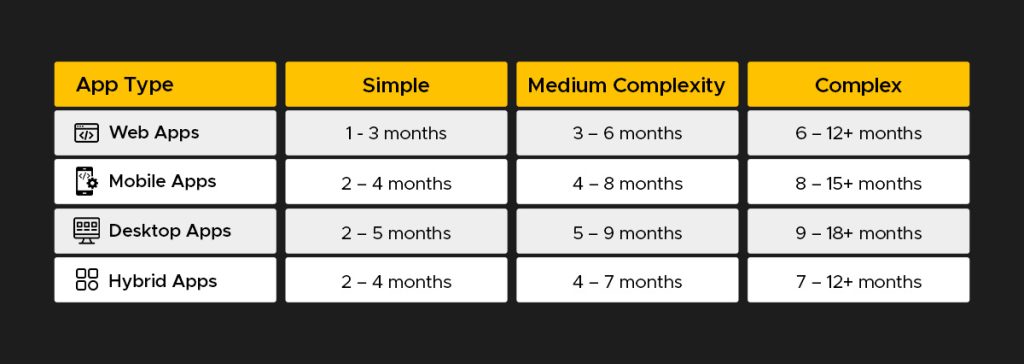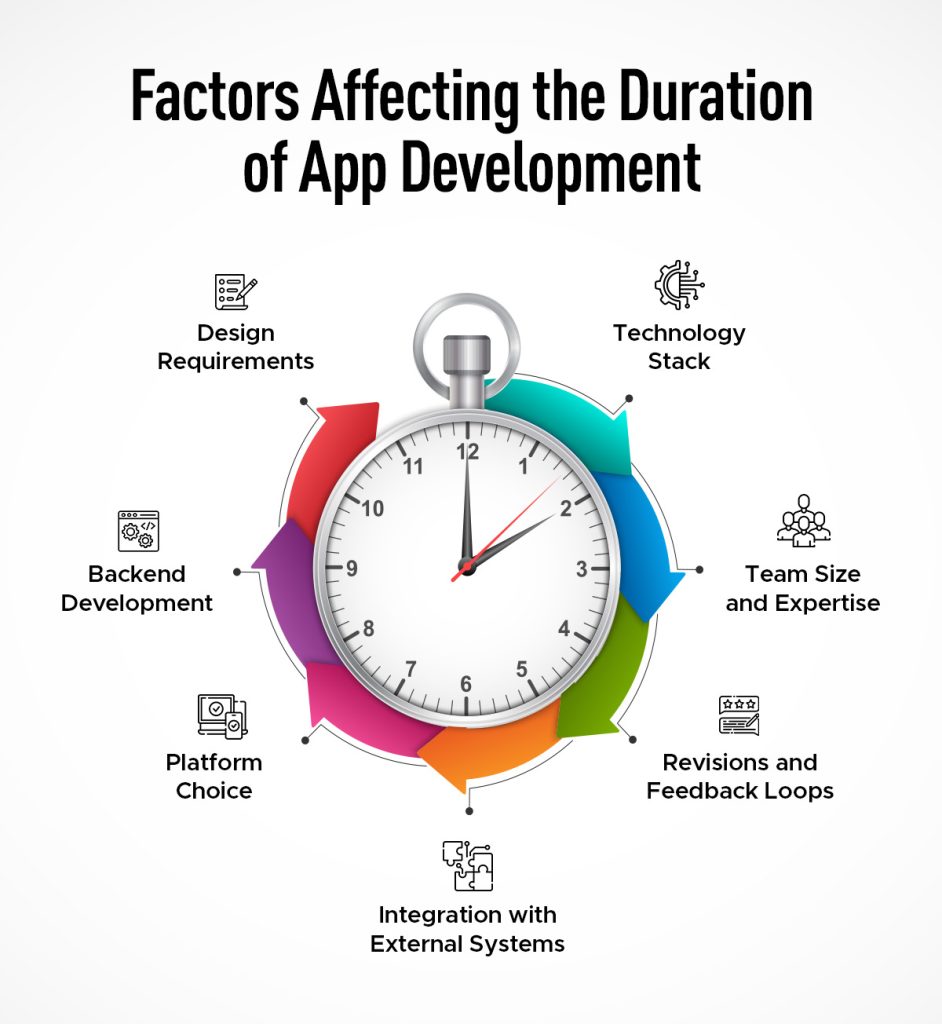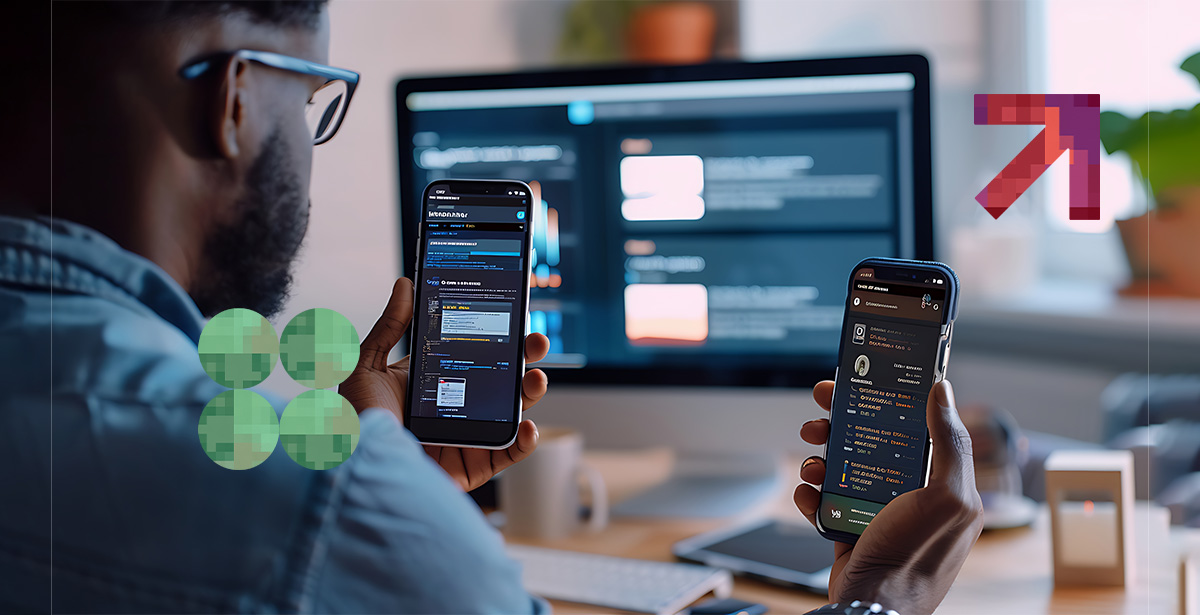How Long Does It Take to Make an App? (Only Facts)

Whether you’re an appreneur or business decision maker, you can’t go wrong with an app –
- A web app can expand your reach, improve customer engagement, and streamline operations.
- A mobile app can boost accessibility, strengthen customer loyalty, and deliver personalized experiences.
- A desktop app can enhance performance, support complex tasks, and offer robust offline functionality.
- A hybrid app can reduce development time, lower costs, and reach users across platforms with a single codebase.
But regardless of which type of app you have in mind, you’re bound to wonder, “How long does it take to make an app?” After all, the answer will help you identify several aspects, including the cost of your application.
💡When planning your mobile app, consider building a Progressive Web App (PWA). PWAs blend the best of web and mobile as they run in browsers yet feel like native apps. This means you get offline access, push notifications, and lightning-fast performance without the high cost of separate iOS and Android development. Just make sure to understand everything there is to it before contacting a PWA development company.>
How Long Does It Take to Develop an App?
There are several factors you’ll need to take into consideration before venturing into app development. But before getting to these, here’s a TL;DR version with concrete numbers.
App Development Duration in Numbers
You may spend anywhere between a month and over a year and a half building different types of apps. The table below should give you a better idea of what you can expect.

Web Apps
Web Apps are applications that run through a web browser, accessible across devices without installation. They’re ideal for businesses that aim for scalability and a wide reach.
A simple web app like a basic dashboard or landing platform typically takes 1–3 months. Meanwhile, medium-complexity projects involving user authentication, databases, or API integrations can take 3–6 months. As for highly complex web apps such as enterprise systems with analytics or AI integration, these require anywhere between 6 and 12+ months.
Mobile Apps
Mobile Apps are designed specifically for smartphones and tablets, providing optimized user experiences for iOS, Android, or both.
If you’re wondering how long does it take to make an app for mobile devices, expect to put in at least two months.
Simple mobile apps with limited screens or functionality can be developed quickly. Apps with a little more complexity, such as e-commerce, booking, or social platforms, often take 4–8 months.
In contrast, complex apps that involve real-time data, AR/VR, or multi-platform support can extend to 8–15+ months.
Desktop Apps
Desktop Apps are the programs installed and run directly on Windows, macOS, or any renowned operating system. They’re often used for high-performance tasks or offline functionality.
The simplest desktop apps can take around 2–5 months to build, whereas those with moderate features like data visualization or integrations may need 5–9 months.
Finally, advanced enterprise or cross-platform desktop applications with heavy data operations can take 9–18+ months to develop.
Hybrid Apps
Hybrid Apps combine the best of both web and mobile technologies. They’re built with frameworks that allow one codebase to run on multiple platforms. Therefore, they deliver faster deployment and cost efficiency without compromising on native-like performance.
Development for simple hybrid apps usually takes a minimum of two months. As for medium-complexity projects with backend integration or push notifications,expect 4–7 months.
Meanwhile, complex hybrid apps with advanced offline modes or hardware-level features can take at least seven months or go beyond a year.
What Factors Affect the Duration of Developing Apps?
With the numbers out of the way, let’s go into the details. If you’re really interested in knowing how long does it take to make an app, you should learn about what adds or shortens development time.
In addition to app complexity, the following will impact your project’s timeline:

1) Design Requirements
The more polished and customized the design, the more time it takes.
Apps with custom animations, interactive elements, and unique layouts require extensive UI/UX work and front-end implementation.
On the other hand, apps that use standardized templates or design systems are faster to produce. You’ll need to be prepared for the lack of originality though.
User testing, prototyping, and accessibility considerations further influence duration. But while each iteration adds time, it ensures a smoother user journey.
>💡Make sure to learn everything there is to the design phase. The software development life cycle design phase is where ideas become blueprints. A well-planned design stage defines your app’s architecture, user flow, and visual identity before coding starts. By investing time here, you can prevent costly rework later, ensure seamless user experiences, and align every stakeholder on what’s being built and why.>
2) Technology Stack
The choice of programming languages, frameworks, and tools directly impacts development speed and flexibility.
For example, building a mobile app in React Native or Flutter allows faster cross-platform deployment. But if you’re choosing native development (e.g., Swift for iOS) it’ll take longer. One perk as a result is higher performance.
Similarly, for web apps, using frameworks like Next.js or Laravel can speed up workflows compared to building from scratch.
So, before asking your tech partner how long does it take to make an app, consider doing your research on the right tech stack for your project. You can then weigh the pros and cons to ensure maximum value.
3) Backend Development
The backend refers to everything powering the app’s logic, data processing, and communication with servers. While invisible to users, it’s essential for stability, scalability, and performance.
If your app needs user authentication, databases, APIs, or cloud storage, it requires a robust backend architecture. And building this infrastructure can be time-intensive.
Moreover, backend complexity grows with added features such as real-time updates, analytics, or AI integration.
4) Team Size and Expertise
A team’s capabilities, structure, and experience play a major role in development speed.
A well-structured team, i.e. one composed of specialized roles such as UI/UX designers, front-end and back-end developers, QA engineers, and project managers, can work in parallel across different project components.
This division of labor allows each expert to focus on their area of strength, improving both speed and quality.
On the other hand, smaller teams or startups often rely on multitasking. Few individuals handle design, development, and testing simultaneously. While this setup can be agile and cost-effective, it usually extends a project. Plus, communication and coordination challenges can also emerge without clear workflows and accountability.
Team experience and technical expertise play a crucial role as well. Developers who are well-versed in the chosen technology stack can anticipate potential challenges, write cleaner code, and implement solutions more efficiently.
>💡Before picking your development team, decide which hiring model is right for you. In addition to software development team augmentation, you have the option to hire technology consultants or dedicated teams. Learn about each of these options to determine which is the right fit for your next project.>
5) Platform Choice
Another factor that goes into answering ‘how long does it take to make an app?’ is the type of platform you pick.
First, you need to determine which platform is more suitable for realizing your app idea. Each platform has unique strengths and trade-offs. Which one you pick for your project must rely on your target audience, app functionality, budget, and business goals.
For instance, if your target market primarily uses iPhones and you’re aiming for a premium, high-performance experience, developing a native iOS app may be the best choice.
On the other hand, if your app is content-heavy or service-based (e.g., eCommerce portals), a web app or PWA makes more sense.
6) Revisions and Feedback Loops
Revisions and feedback loops are an essential part of any app development process. With them, developers ensure that what’s being built truly aligns with the client’s vision, user expectations, and business goals.
Thing is, they’ll impact the timeline and cost of development if not managed properly.
Software engineering models such as Agile models are iterative in nature. This means developers build a feature, gather feedback, improve, and retest. As a result, they can identify usability issues, design inconsistencies, or technical gaps early on.
While it adds extra steps, it’s far more efficient to refine during development than to fix major flaws after launch.
Similarly, feedback is a major part of Agile models. Feedback loops are built into every sprint, allowing for quick course corrections and continuous improvement. Stakeholders regularly review progress, share insights, and suggest refinements.
Though this flexibility keeps the app user-focused, it can potentially extend timelines slightly due to additional testing and implementation cycles. So, you need to identify whether you should prioritize predictable timelines or room for real-time feedback.
And while we’re still on the topic of feedback, remember that frequency and quality matter in
Clear, timely, and well-documented feedback from stakeholders speeds up adjustments, while delayed or conflicting inputs can cause bottlenecks and confusion among team members. You can also use tools like Jira or Figma to complement structured review processes.
7) Integration with External Systems
While crucial, integration with external systems is often quoted as an answer to ‘how long does it take to make an app?’
Modern applications frequently need to connect with third-party platforms, enterprise systems, or cloud services to deliver seamless functionality and real-time data exchange.
These integrations can range from simple to highly complex. For example, basic integrations might include connecting your app with payment gateways like Stripe or PayPal. On the other hand, more advanced integrations might involve linking with the like ofAI-driven APIs. Such integrations require careful configuration, data mapping, and security handling.
The complexity of these integrations significantly impacts development duration. Developers must thoroughly understand how each external system communicates.
But inconsistent or outdated API documentation can slow them down. Similarly, limitations or frequent updates from third-party providers can introduce additional challenges.
Integration testing is another critical phase that adds to the timeline.
Once systems are connected, developers must verify that data flows correctly, latency is minimal, and security protocols are fully compliant. Any errors can later become data mismatches, performance issues, or security vulnerabilities later.
For enterprise or large-scale apps, integrations often extend to internal company systems like inventory systems or accounting software. These projects require close collaboration with your organization’s IT or operations teams to align databases, user permissions, and workflows.
Actual integrations aside, how many your project needs impact the timeline. Each new connection adds layers of dependencies that must be maintained over time. This also means ongoing monitoring and updates whenever a system changes its API or security policies.
App Development Tips from Our Experts
Now that you have your answer to ‘how long does it take to make an app?’, let’s help you find ways to speed things up.
- Define Clear Goals – Know your app’s purpose, audience, and success metrics before even contacting a development team.
- Prioritize Design – A thoughtful UI/UX design ensures intuitive navigation, higher engagement, and fewer revisions down the line. Great design lays the foundation for great performance.
- Look for a Skilled Team – Experienced, well-coordinated teams deliver faster and higher-quality results.
- Embrace Feedback – Regular reviews and iterations lead to a more polished, user-friendly app.
- Go Cross-Platform for Mobile Apps – Consider leveraging cross platform development when working on mobile apps. Platforms like Flutter or React Native save time and cost across devices.
- Think Beyond Launch – Continuous updates, user feedback analysis, and performance monitoring ensure your app evolves with market needs and remains competitive.
Got a Custom App Development Idea in Mind?
Whether it’s a mobile, web, or desktop solution, our experts can turn your vision into a powerful, user-friendly product.
We build apps that drive engagement, efficiency, and growth. All while tailored exactly to your business goals. So, let’s bring your idea to life.





